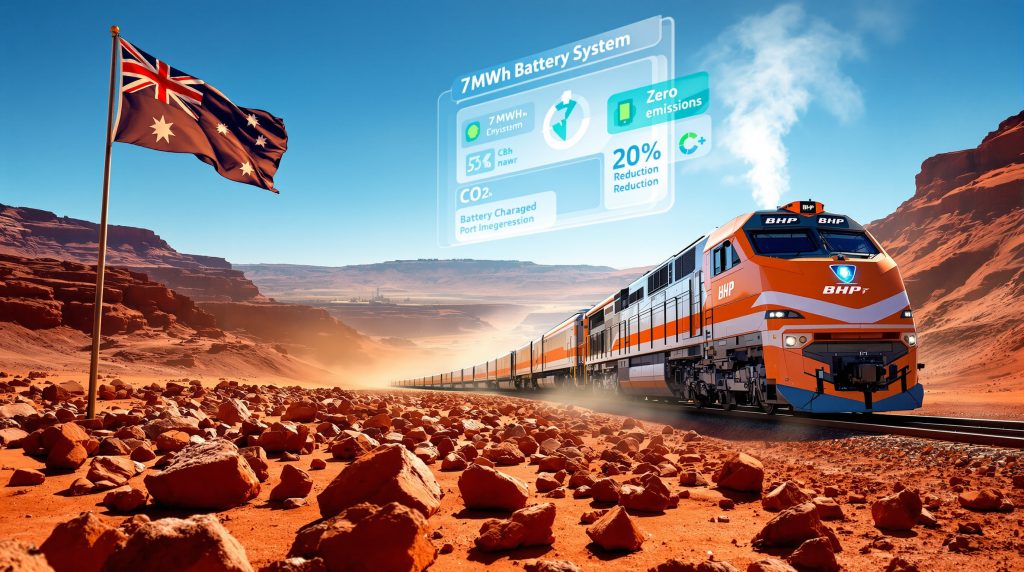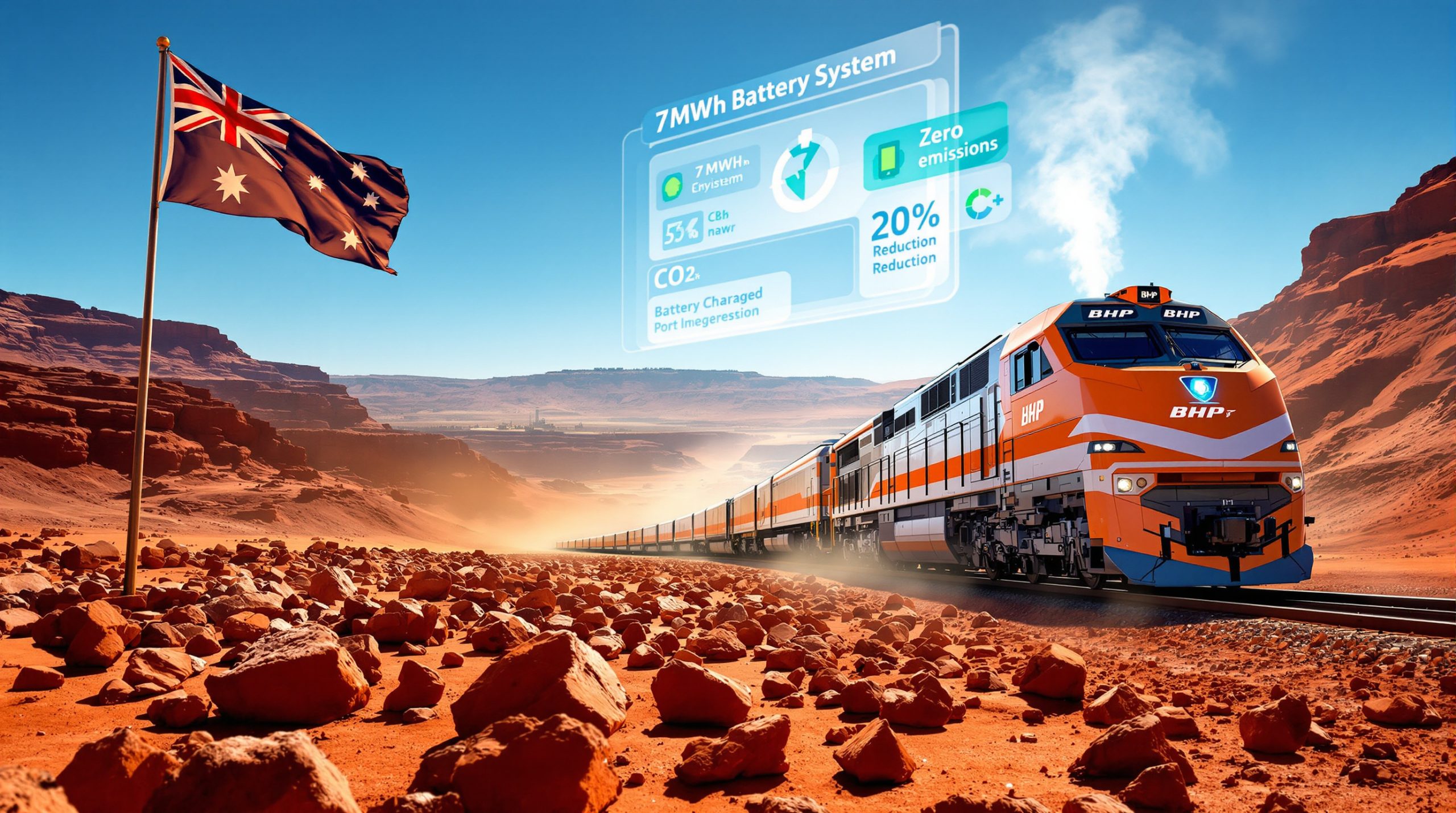Revolutionary Electric Rail Technology Arrives in Australia
Australia's mining sector has witnessed a groundbreaking development as BHP launches Australia's first electric locomotives. These innovative machines represent a transformative shift away from traditional diesel-powered rail transport, introducing zero-emission technology to one of the country's most carbon-intensive industries. Furthermore, this deployment showcases how mining industry innovation is driving sustainable transformation.
The battery-electric locomotives combine sophisticated energy storage systems with regenerative braking capabilities, specifically engineered to handle the extreme operational demands of Western Australia's Pilbara region. Unlike conventional rail electrification that relies on overhead power lines or third rails, these units operate entirely on stored battery power, making them ideally suited for remote mining environments where electrical grid infrastructure remains limited.
Breakthrough Technology for Mining Transportation
The deployment marks the culmination of extensive research and development efforts focused on adapting electric mining transportation technology for heavy-haul mining applications. Each locomotive incorporates advanced battery management systems designed to maintain optimal performance under the harsh conditions typical of Australian mining operations, including extreme temperatures, dust exposure, and continuous duty cycles.
This technological advancement addresses a critical gap in Australia's mining transportation infrastructure, where diesel fuel consumption has historically represented a major source of operational emissions. The introduction of battery-electric alternatives creates new possibilities for reducing the carbon footprint of mineral transport operations across the continent.
Advanced Battery Systems Engineered for Extreme Conditions
Each locomotive features a comprehensive 7-megawatt-hour battery system paired with sophisticated liquid cooling technology specifically designed to function in temperatures exceeding 45°C. This thermal management approach ensures consistent performance even during the extreme heat events common in Western Australia's mining regions.
The battery architecture incorporates regenerative braking technology that captures kinetic energy during downhill operations and converts it back into usable electrical power. This energy recovery system extends operational range while simultaneously reducing overall energy consumption, creating efficiency gains that compound throughout extended duty cycles.
Liquid Cooling Innovation for Battery Longevity
The liquid cooling systems represent a critical engineering solution for maintaining battery performance in one of the world's most thermally challenging mining environments. These systems actively regulate cell temperatures to prevent thermal degradation that could compromise operational lifespan or reduce energy storage capacity.
Key Technical Features:
- 7MWh lithium-ion battery systems per locomotive
- Liquid cooling technology rated for continuous operation above 45°C
- Regenerative braking with energy recovery capabilities
- Thermal management systems designed for extended duty cycles
The energy recovery capabilities enable locomotives to capture momentum during loaded downhill runs, feeding recovered power back into the battery system. This regenerative approach can provide substantial energy savings across typical mine-to-port routes that feature significant elevation changes.
Heavy-Haul Performance Matching Diesel Capabilities
The electric locomotives maintain equivalent hauling capacity to their diesel counterparts, designed to pull standard iron ore consists without compromising operational throughput. According to BHP's official announcement, these units can handle the same 270-car trains carrying approximately 38,000 tonnes of iron ore per journey that define current Pilbara rail operations.
This performance parity represents a crucial achievement for electric rail technology adoption in mining applications. Previous electric locomotive deployments often required operational compromises or route modifications, but these purpose-built units deliver the torque and tractive effort necessary for existing heavy-haul operations.
Maintaining Operational Continuity
The locomotives utilise electric drive systems engineered to provide equivalent pulling power to proven diesel-electric units currently operating across BHP's 180-locomotive Pilbara fleet. This approach ensures seamless integration with existing rail operations while eliminating the need for consist size reductions or operational schedule modifications.
Performance Specifications:
- Equivalent tractive effort to existing diesel locomotives
- Standard 270-car consist compatibility
- 38,000-tonne payload capacity per train
- No operational schedule modifications required
The electric drive systems deliver consistent power output across varying grades and operational conditions, maintaining the reliability standards essential for continuous mining operations where equipment downtime directly impacts production targets.
Real-World Testing in Pilbara Mining Conditions
Following commissioning procedures, both electric locomotives will undergo comprehensive field trials across BHP's iron ore rail network, spanning routes between active mining sites and Port Hedland export facilities. These trials will evaluate multiple performance parameters under actual operational conditions rather than controlled testing environments.
The testing program focuses on validating battery performance, charging efficiency, and operational reliability under the extreme heat and dust conditions characteristic of Pilbara mining operations. Real-world trials provide critical data on component durability, energy consumption patterns, and maintenance requirements that cannot be replicated in laboratory settings. Additionally, this testing phase will leverage data-driven operations to optimise performance.
Comprehensive Performance Evaluation
Trial protocols will measure battery charge retention across multiple duty cycles, evaluate charging infrastructure performance, and track component reliability under continuous operational stress. The testing phase will generate data comparing electric locomotive performance directly against the existing diesel fleet's established performance benchmarks.
Critical Testing Parameters:
- Battery life performance under extended operational cycles
- Charging efficiency and infrastructure compatibility
- Component reliability in dust-laden environments
- Thermal management system effectiveness above 45°C
- Energy consumption per tonne of ore transported
The trials will also assess integration challenges with existing rail operations, including scheduling coordination, maintenance protocols, and operational support requirements for battery-electric technology in remote mining locations.
Benchmarking Against Established Diesel Operations
The testing phase will systematically compare electric locomotive performance against BHP's existing fleet of approximately 180 diesel units, measuring critical factors including energy consumption, maintenance requirements, and total operational costs per tonne of ore transported. This comprehensive benchmarking approach will provide quantitative data supporting potential fleet conversion decisions.
Comparison metrics will encompass fuel costs versus electricity expenses, maintenance frequency and complexity, component replacement intervals, and overall system reliability. Consequently, the economic analysis will consider both direct operational costs and indirect factors such as emissions compliance expenses and carbon pricing exposure.
Economic Performance Analysis
The benchmarking program will evaluate total cost of ownership across multiple operational parameters, comparing diesel fuel consumption rates with electrical energy requirements per tonne-kilometer of transport service. Maintenance cost structures will be analysed to identify potential savings from reduced component complexity in electric drive systems.
| Comparison Metric | Diesel Baseline | Electric Performance | Expected Outcome |
|---|---|---|---|
| Energy Cost per Tonne | Diesel fuel pricing | Grid electricity rates | Variable based on energy sources |
| Maintenance Frequency | Established intervals | To be determined | Potentially reduced complexity |
| Component Lifespan | Known parameters | Under evaluation | Extended operational life expected |
| Operational Reliability | Proven performance | Testing phase data | Equivalent reliability target |
The analysis will also consider operational flexibility factors, including response to demand fluctuations, scheduling adaptability, and integration with existing fleet management systems.
Significant Emissions Reduction Potential for Western Australia
Complete electrification of BHP's Pilbara locomotive fleet could achieve approximately 30% reduction in the company's Western Australian iron ore diesel-related carbon emissions annually. This reduction represents a substantial contribution toward BHP's 2030 target of 30% operational greenhouse gas reduction across its global operations. Furthermore, this initiative exemplifies the significant decarbonisation benefits available to the mining sector.
The emissions reduction calculation reflects the elimination of direct diesel combustion emissions from rail transport operations. However, the actual carbon footprint reduction depends on the electricity generation sources used for battery charging, highlighting the importance of renewable energy integration for maximising environmental benefits.
Quantifying Environmental Impact
Current diesel fuel consumption accounts for approximately 70% of Pilbara mining emissions, with railway operations representing a major contributor to this total. The transition to battery-electric locomotives directly addresses this significant emissions source while maintaining operational performance standards.
Emissions Impact Analysis:
- Direct Emissions: Complete elimination of diesel combustion emissions from rail operations
- Indirect Emissions: Dependent on electricity generation sources for charging
- Net Reduction: Estimated 30% decrease in WA iron ore transport emissions
- Strategic Alignment: Contributing to broader 2030 decarbonisation targets
The environmental benefits extend beyond direct emissions reduction to include improved air quality in mining areas and reduced noise pollution compared to diesel locomotive operations. These secondary benefits contribute to enhanced working conditions and reduced environmental impact on local communities.
Integration with Australia's Energy Transition Strategy
The electric locomotive program aligns strategically with Western Australia's Pilbara Energy Transition plan, which aims to establish common-use transmission infrastructure for renewable energy delivery to heavy industry across the region. This synchronisation creates opportunities for locomotives to operate on clean electricity rather than grid power derived from fossil fuel sources. In addition, successful renewable energy integration could maximise the environmental benefits of this technology.
The integration supports infrastructure development for broader mining sector electrification, potentially catalysing adoption of electric heavy machinery beyond rail transport. The locomotive trials establish precedents for battery-electric vehicle infrastructure in remote mining locations where grid connectivity remains limited.
Supporting Regional Decarbonisation Infrastructure
The Pilbara Energy Transition plan envisions private sector development of shared transmission infrastructure capable of delivering renewable energy to multiple industrial users. This approach could provide clean electricity sources for locomotive charging while supporting broader regional decarbonisation objectives.
Strategic Infrastructure Benefits:
- Alignment with regional renewable energy development
- Shared transmission infrastructure utilisation
- Precedent for mining equipment electrification
- Support for broader industrial decarbonisation
The locomotive deployment demonstrates practical applications for renewable energy storage and distribution in remote industrial environments, contributing to the business case for expanded clean energy infrastructure development.
Technical Challenges in Extreme Mining Environments
Battery performance in Pilbara temperatures that regularly exceed 45°C presents significant thermal management challenges requiring specialised cooling systems to prevent performance degradation. The extreme heat conditions can accelerate battery aging and reduce energy storage capacity if not properly managed through active cooling technologies.
Range and charging infrastructure requirements represent additional technical considerations for successful deployment. The 7MWh battery systems must provide sufficient energy storage for complete mine-to-port journeys while maintaining reserve capacity for unexpected operational demands or charging delays.
Critical Technical Considerations
The locomotives must demonstrate reliable operation across extended distance routes while maintaining compatibility with existing rail network infrastructure. Charging speed capabilities need to minimise operational downtime while providing adequate energy storage for sustained heavy-haul operations.
Technical Challenge Areas:
- Battery Range: Sufficient power storage for complete operational cycles
- Charging Speed: Rapid charging to minimise downtime between cycles
- Grid Integration: Compatibility with existing electrical infrastructure
- Maintenance Access: Serviceability in remote mining locations
- Component Durability: Extended operational life under harsh conditions
The technical validation process will identify any performance limitations or infrastructure modifications needed for successful commercial deployment across BHP's broader rail network operations.
Global Context of Battery-Electric Heavy-Haul Technology
While electric trains operate extensively worldwide, battery-electric locomotives specifically designed for heavy-haul mining applications remain relatively uncommon in commercial operations. Most existing electric rail systems rely on continuous power supply through overhead lines or third rails, making battery-powered approaches particularly innovative for remote mining environments.
The collaboration with Wabtec leverages the company's FLXDrive locomotive platform, specifically engineered for heavy-duty industrial applications. This partnership combines Australian mining operational expertise with international rail technology innovation, creating customised solutions for unique operational requirements.
International Technology Transfer
The FLXDrive platform represents advanced battery-electric locomotive technology adapted for Australian mining conditions. This technology transfer approach accelerates development timelines while ensuring proven engineering solutions are modified for local operational demands.
The deployment represents a significant milestone for heavy-haul rail innovation, combining advanced battery technology with regenerative braking to deliver high efficiency and lower emissions in one of the world's most demanding operational environments.
The international collaboration model demonstrates how global technology platforms can be customised for specific regional requirements while maintaining proven performance characteristics. As highlighted by Australian Mining, this represents a landmark achievement in sustainable mining transport.
Long-Term Implications for Australian Mining Transportation
Successful trials could accelerate battery-electric locomotive adoption across Australia's broader mining sector, particularly for companies operating in regions with renewable energy access. This technology transfer could extend beyond iron ore transport to coal, gold, and other mineral transport operations throughout the continent.
The economic benefits extend beyond environmental compliance to include reduced exposure to fuel price volatility, potentially lower maintenance costs due to simplified electric drive systems, and enhanced corporate sustainability credentials valuable in international markets.
Industry-Wide Adoption Potential
The demonstration of viable battery-electric technology for heavy-haul mining applications creates precedents for similar deployments across Australia's resource sector. Companies operating rail transport systems for coal, mineral sands, or other commodities could adapt similar technologies for their specific operational requirements.
Potential Economic Advantages:
- Fuel Cost Stability: Reduced exposure to diesel price volatility
- Maintenance Efficiency: Simplified electric systems vs. diesel engines
- Operational Benefits: Regenerative braking improves energy efficiency
- Market Position: Enhanced sustainability credentials for international customers
The technology could influence infrastructure investment decisions across the mining sector, particularly as carbon pricing mechanisms expand and environmental regulations become more stringent.
Competitive Positioning for Carbon-Constrained Markets
Early adoption of low-emission transportation technologies positions Australian mining operations advantageously for future carbon pricing scenarios and evolving environmental regulations. As global carbon pricing mechanisms expand, companies with established low-emission operations will face reduced compliance costs and regulatory risks.
Major steel producers and industrial customers increasingly prioritise supply chain sustainability, making emission-reduced iron ore transport a competitive advantage in markets where environmental credentials influence purchasing decisions. This trend particularly affects exports to regions with strong climate commitments and carbon border adjustments.
Meeting International Sustainability Demands
The locomotive deployment demonstrates commitment to operational decarbonisation that aligns with international customer expectations for low-carbon mineral supply chains. European and Asian steel producers face increasing pressure to source raw materials from environmentally responsible suppliers.
Market Competitive Factors:
- Carbon Pricing: Preparation for expanded carbon tax scenarios
- Regulatory Compliance: Early adoption reduces future compliance risks
- Customer Requirements: Meeting international sustainability standards
- Market Access: Maintaining competitiveness in carbon-conscious markets
The initiative positions Australian iron ore exports favourably for markets implementing carbon border adjustments or sustainability-linked purchasing criteria.
Future Development and Fleet Expansion Strategy
Following successful completion of the trial phase, BHP will evaluate broader fleet conversion possibilities based on comprehensive performance data, infrastructure investment requirements, and economic viability compared to continued diesel operations. The assessment will consider factors including battery technology advancement, charging infrastructure costs, and operational performance validation.
Future developments may include integration with dedicated renewable energy sources, creating fully renewable-powered rail transport systems that eliminate fossil fuel dependency entirely from mine-to-port iron ore logistics. Solar and wind installations could provide dedicated clean electricity for locomotive charging operations.
Renewable Energy Integration Opportunities
The expansion strategy could incorporate direct renewable energy connections, potentially including dedicated solar installations or wind farms designed specifically for locomotive charging requirements. This approach would maximise emissions reduction benefits while providing energy cost stability for long-term operations.
Development Pathway Considerations:
- Performance Validation: Comprehensive trial data analysis
- Infrastructure Investment: Charging network expansion requirements
- Economic Viability: Total cost comparison with diesel alternatives
- Technology Evolution: Battery advancement and cost reduction trends
The strategic timeline will depend on trial results, technology cost trends, and regulatory developments affecting carbon pricing and emissions compliance requirements. However, as BHP launches Australia's first electric locomotives, the initiative establishes a foundation for broader industry transformation toward sustainable transportation solutions.
Disclaimer: This analysis involves forecasts and projections regarding technology adoption, emissions reduction potential, and economic impacts. Actual results may vary based on operational performance, technology advancement, regulatory changes, and market conditions. Investment and operational decisions should consider comprehensive risk assessment and professional consultation.
Looking to Stay Ahead of Australia's Mining Innovation Wave?
Discovery Alert's proprietary Discovery IQ model provides instant notifications when ASX mining companies announce breakthrough technologies and operational developments like these electric locomotive deployments, ensuring investors identify actionable opportunities before the broader market reacts. Begin your 30-day free trial today to discover how major mining innovations can generate substantial returns for early-positioned investors.




